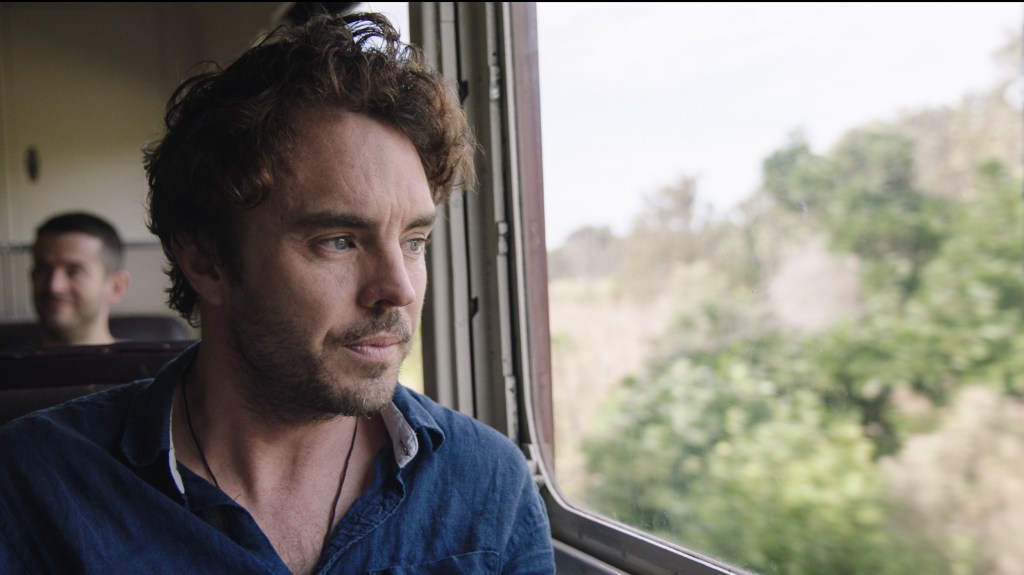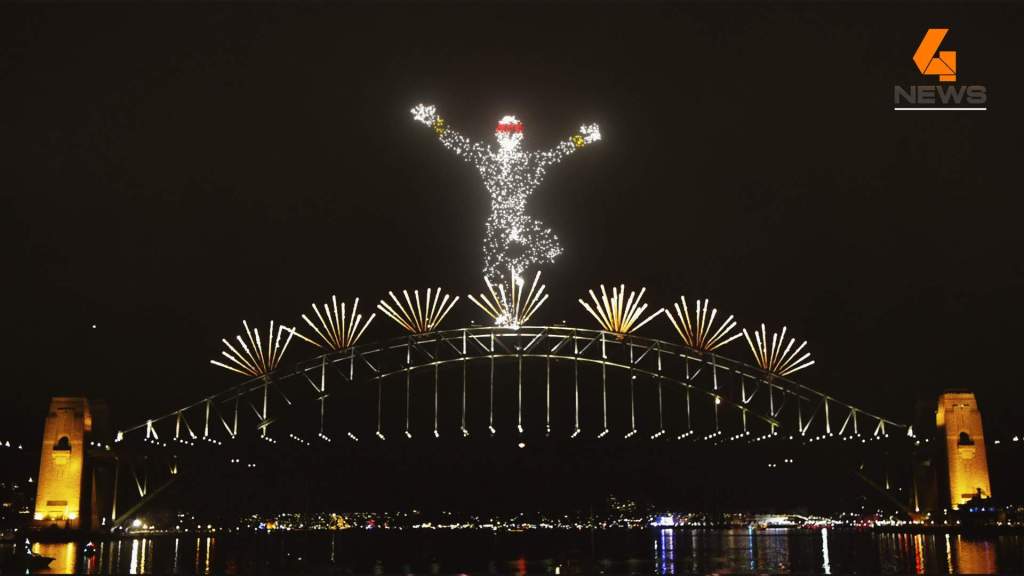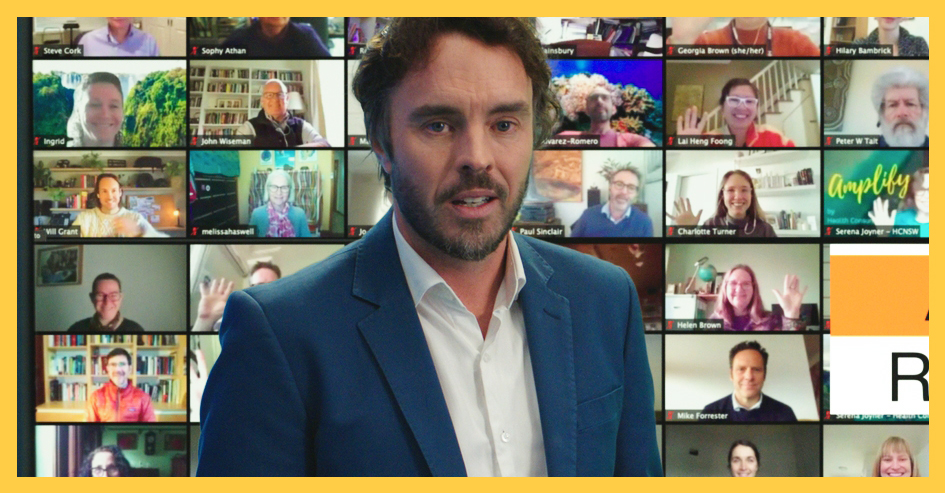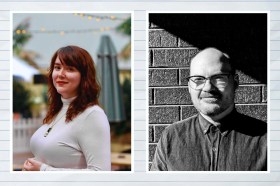When you think about the future, what do you see? Flying cars? Jetpacks? Alien overlords? Well, how about highspeed trains, offshore wind farms, solar-powered and greenified cities, and Indigenous land rights?

Damon Gameau (That Sugar Film) has thought a lot about our future. While our present Australia floods and burns, and the world heats up one catastrophic degree at a time, he keeps a hopeful eye on the horizon.
We sat down with Damon at the 2022 Australian International Documentary Conference (AIDC) to talk about his new film Regenerating Australia, and about what Australia’s climate future could be…
This film almost comes across as utopian, and I sensed some underlying sadness that this isn’t the reality we are already living in …
I really appreciate you saying that, but a lot of those things [in the film] are already happening. It just seems utopian because we don’t talk about them enough. We have one of the most concentrated media landscapes in the world, in fact we’re ranked in the top five. Obviously we know the Murdoch one has 70% of distribution of newspapers, but even our mainstream media are all deeply connected to extractive industries and keeping the status quo. And that means so much of this [climate change] stuff is just bubbling away, just below the surface. But more and more people are springing into action. So I’m really bullish that we’re actually not far from a tipping point where climate action will become the norm.
In this election, we’ve got a phenomenal amount of independent candidates. All of them are running really powerful climate policies, and there’s a handful of them that have a legitimate shot of winning. And if that happens, we’ll start building all these batteries and electric buses, and more solar farms and green communities. Also, the surveys show that almost 80% of people are supportive of a First Nations voice in our parliament. So there’s a big consensus that we want this, there’s just a very small group of people that control our media and our policies, but once they go, things could change very quickly in this country.
We spent a lot of time making sure this film wasn’t Pollyanna, or was grounded in really solid evidence and research that assured we could pull this off by 2030. That’s important, because I don’t want it to just be a fantasy film. It has to be relatable enough that people will do their own research and say ‘Oh, actually, that project already happening here, someone is doing those community batteries, and that solar garden thing is already real’. So that’s the work we have to do now. This isn’t as far away as it might seem.
Who needs to see this film the most?
I would love as many Australians as possible to see it, obviously, so that we can create that wider cultural shift. But I also think it needs to be seen by leaders in their community, policy makers, decision makers, councils, the ones that really understand the mechanics of what needs to happen to bring these changes to life. We’ve had 80 years of a particular system that’s very entrenched, and people don’t want to change that.
I would love corporate leaders and government groups to see this. But I also think that disillusioned youths need to see it, so they can see what is possible. Maybe it will give them hope that you can still be an engineer, you can still be an architect, but the kinds of buildings you make and the materials you use will be different. We can’t keep teaching kids the same things we’ve always taught them, because the world is changing so quickly, and we’re already seeing the realities of climate change.
Why did you decide to make it a fictional piece in the style of a documentary?
Well, our brains love novelty. It was a matter of finding which narrative device would cut through. I also wanted to move away from the graphs and spreadsheet reports you see all the time, and create a really visceral-feeling film. That was a challenge, because if it’s not done well it can be really hokey. So I spent a lot of time trying to find people that weren’t actors, and doing enough takes until it felt natural. In fact, during some of the early screenings people would get confused and ask me if the film had actually happened or not. So I ended up putting year-markers in too. I took that as a strange compliment, because realism was our intention. And it’s made people more emotionally engaged.

I also didn’t want it to be another story of how the forest burned and the koalas died. I think if you’ve seen it on the news enough times, you’re not going to go and sit for an hour and a half and care about it. It’s about being strategic with storytelling in this moment.
Read: Eva Orner on her climate-change film: ‘Vote as if your life depends on it’
A lot of films do focus on the devastation of climate change. What made you stay positive?
I don’t think one viewpoint is better than the other. I think there needs to be a balance of being honest about where we’re at, but then also providing solutions. In most environmental films they use 95% of the story to show how bad it is, and then there might be a couple of minutes of hope at the end. We wanted to flip that and go: ‘Right, here’s where we’re at, now let’s see where we could go if we did this and that’. I think a lot of people have been tricked into believing that taking action on climate change means sacrificing so many things. Yet there are many things to gain from taking action, and we just haven’t sold that well enough.
It does make sense to wake people up and tell them ‘Quick! You’ve got to act!’ But we’re so saturated with that right now. The psychology says that it can really paralyse people to the point where they can’t even process it, so instead they go and watch a Marvel film. And that’s the most dangerous thing to let happen at this moment.
Can you talk about the visual effects used in the film?
Oh, that was fun. It was very exciting to trawl through stock footage and pick out things that could be re-contextualised. Obviously, we don’t have high-speed electric trains in Australia, so I found all these shots from Chinese or Japanese train stations and we used VFX to change the signs to show Melbourne Central and so on. We also used the graphics to demonstrate what a decentralised energy system might look like. That’s where visuals can be so handy, because they articulate the message and get people to understand things like decentralising an energy grid and how the energy will be transported.

But the real challenge was showing enough in 17 minutes. How do you condense an idea and express it in a very short amount of time, especially when we’re dealing with future concepts? We had to break from the VFX device a little bit and explain things while still keep the pace and the momentum. And we had to do this without overwhelming people. So the human element, as opposed to the VFX, was the key. That and the beautiful score written by Amelia Barden. The whole thing was a really interesting craft exercise.
Can you tell me more about carbon offsetting in the film industry?
It’s a line item in your budget that offsets your carbon footprint from the film. That’s something a lot of countries are doing already, and we’re about 10 years behind in Australia. Just think about flying actors in from all around the world, the amount of crew coming to set, the amount of food being used, and the plastic waste. Film crews leave a huge imprint, especially on some of the bigger budget productions. So, at what point do we take responsibility?
Read: Quick tips for more sustainable screen production
There’s not much pressure put on our industry; instead everyone talks about the fashion industry, the food industry and so on. So film has gotten away with a lot. I love to think that carbon offsetting will become standard item on any budget. Then you can choose different ways you want to offset, whether that’s reforestation, protecting a particular area like we did in Indonesia, or something else.
I think we’ve got to also understand that offsets are not going to completely mitigate the damage we’ve done, but if everyone started doing it we’d obviously turn the problem around much faster.
For those people who already do everything they can to be sustainable, and those that vote with climate in mind, what else can they do to achieve the vision shown in Regenerating Australia?
I mean, those two things are terrific already. The other thing that would be great is to just keep the conversation about climate change going. We’ve also got a section on our website that links to solutions you can be a part of. It’ll ask you a few questions about yourself, and then show you 10 things that you could start doing, and some organisations you could join. And hopefully, because it’s aligned with what you’ve put in, you might go, ‘Oh, I could do that’. And that’s how we build a regenerative network of people that can connect around these issues.
What’s your advice to people who want to use filmmaking to inspire change?
We’re talking about bringing in a workshop or a mentorship, because a lot of young filmmakers reach out to us and ask for help. I’d do it for free. I’d tell you to really think hard about how you’re going to tell your story in this moment. And understand just how much noise is out there, and how tricky it is to get content to cut through. We’re competing with companies that have huge amounts of money, so we’ve got to be really clever, but good stories will always cut through. So take the time to get the script right, and how you’re going to tell the story.
What’s next for you?
I’m on a pretty all-consuming tour for Regenerating Australia at the moment. Then we’re launching the Regenerators platform, which is a free hub for people that want to tell these stories and link them to action. There’ll be no passive content there, so the minute you see something you’re offered a way to connect and learn more.
Beyond that, I have a few ideas floating around but I’m not sure I’ll jump on them straight away. I have to be a dad as well. And this work does take a heavy toll on my family. So at some point I have to regenerate myself as well, because I’ll just get burnt out. The election is coming up too, and it’ll probably be one of our most important ever, given what’s happening in our country. So I really just want this film to go far and wide and make people think about what’s coming up for them.
Screenings of Regenerating Australia will tour nationally throughout 2022. For showings near you, see the Regenerators website.





